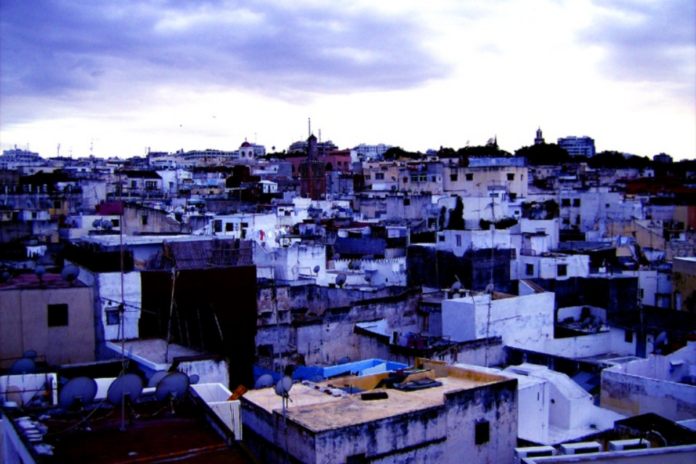Iain Finlayson revisits Tangier for the first time in two decades as we unveil the re-release of “Tangier: City of the Dream,” reflecting on the city’s rich history and enduring charm.
“A dream concealed in stone… sky supersonic, orgone blue, warm wind…Such beauty, but more than that, it’s like the dream is breaking through.”
– William Burroughs
Tangier: A Literary Haven And Cultural Icon
Through the literary works of authors like Paul Bowles and William Burroughs and the memoirs of notable figures such as Edith Wharton, Truman Capote, and Tennessee Williams, Tangier endures as a city steeped in history and allure. Despite facing challenges over the years, particularly during the period following World War II when it was known as “Interzone,” Tangier continues to thrive.
Its association with renowned writers and celebrities has cemented its place in the literary imagination, akin to Dublin’s connection with James Joyce or Graham Greene’s creation of “Greeneland.” More than just a physical location, Tangier is a city of the mind, an atmosphere rich with imagination, experimentation, and the blending of truth and fiction.
While Tangier occupies a significant place in the literary imagination, it also exists as a tangible reality inhabited on various levels. The permanent expatriate community, primarily comprising Americans and Europeans, refers to themselves as Tangerinos, while indigenous residents are known as Tanjaouis.
The city itself intricately layers its landscape: expatriates often inhabit villas nestled on wooded slopes known as “the Mountain,” which overlook the bustling boulevards, shops, and cafes of the port and commercial area. Below this lies the Kasbah and Medina, characterized by narrow streets and bustling market squares primarily occupied by Tanjaouis, with occasional foreign residents.
Also Read: UFO Religion: Flying Saucer Cults and Crashes
Tangier: A Meditative Crossroads
Tangier stands as a city at the crossroads of North Africa and the Mediterranean, embodying a dual identity that gazes both backward to Africa and forward to Europe. Despite being historically viewed as an outlier by the rest of Morocco, tainted by the presence of non-Muslims, its geographical ties remain firmly rooted in Moroccan tradition. However, its complex history of foreign influence and its diverse international culture lend it an ambiguous outlook, with its gaze extending across the Strait of Gibraltar to Europe.
Like the wartime portrayal of Casablanca as a transient refuge for wartime refugees, Tangier has served and continues to serve as a transient stopover for asylum seekers and economic migrants seeking better opportunities elsewhere.
Tangier’s Resurgence In The 21st Century
In the 21st century, Tangier has experienced a revival in popularity, becoming hip and cool once again. However, contrary to the dreams of certain local entrepreneurs and national commercial interests, it has not transformed into a glitzy tourist resort characterized by casinos, large hotels, and beach culture. Instead, the tourists seek something different from Tangier. They love its ethnic diversity and authenticity amidst a globalized culture.
Many visitors search for the mythical, poetic, and haunted city portrayed in the works of authors like Bowles, Burroughs, and the Beats, infused with a sense of desire and despair. Additionally, the influence of Patricia Highsmith’s novels, with their portrayal of criminal amorality, adds to Tangier’s allure. This blend of literary inspiration and real-life ambiance appeals to tourists seeking an authentic and immersive experience in the city.
Tangier’s Multifaceted Population: A Cultural Mosaic
The characters depicted in “Tangier: City of the Dream” primarily hail from American, British, and Moroccan backgrounds. However, another book could explore the diverse array of individuals from French, Spanish, Italian, Dutch, German, Scandinavian, and various Moroccan backgrounds who have shaped Tangier’s development – or as Paul Bowles would have described it, its degradation – from the mid-19th century to the end of the 20th century.
During this period, notable figures such as Alexandre Dumas, Garibaldi, Hans Christian Andersen, and Mark Twain visited the city, leaving their mark alongside a multitude of novelists, artists, photographers, adventurers, and scoundrels. This rich tapestry of cultural influences has contributed to the unique identity and allure of Tangier throughout its history.
Reflections On Tangier: A Personal Journey
Since the early 1990s, I hadn’t returned to Tangier, feeling incredibly fortunate to have experienced it at the twilight of an era. My gratitude extended to David Herbert, known as the long-term ‘King of the Mountain,’ whose influence within the expatriate community opened doors to vital connections. I also cherished the patient guidance and insights offered by Paul Bowles and his circle of friends, who imparted invaluable knowledge about the essence of Tangier.
Moreover, I owed a debt of gratitude to a young French cultural attaché in Tangier named Daniel Laurain, whose introduction to the local Riffian culture, musicians, and kif left an indelible impression, revealing the city’s magical essence.
Tangier’s Timeless Essence
During a day trip to Tangier from Gibraltar in November, I discovered that the city remained largely unchanged at least on the surface. While developers had expanded and adorned the modern hub around the Cafe de Paris with decorative touches, they had also erected new, luxurious villa constructions on the wooded ‘Mountain’ overlooking the city.
However, the medina – well, the medina appeared simply twenty-five years older. Despite the passing of time, I could still navigate its narrow alleyways and find myself back in the Petit Socco. This enduring quality embodies the foundation of Tangier’s tradition. It will remain steadfast even as transient layers added by travelers, tourists, and transients gradually fade away over time.

Iain Finlayson, renowned for his biographies of James Boswell and Robert Browning, as well as his diverse works exploring topics like the Scots, writers of Romney Marsh, and denim, has authored “Tangier: City of the Dream,” which has been re-released this week. Additionally, he serves as the book editor for Saga Magazine and contributes book reviews to The Times.


